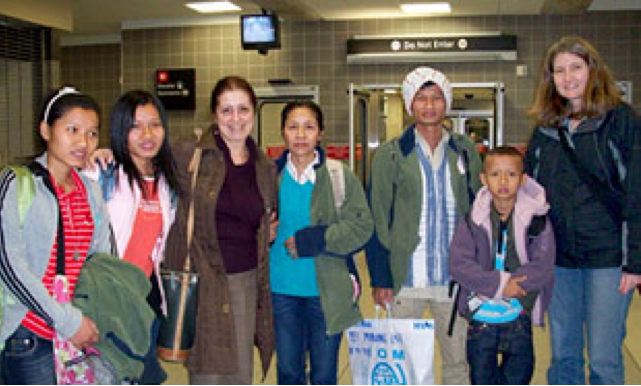
https://vimeo.com/25516777]

Immigration has been a long withstanding aspect of Philadelphia culture. Individual and families from Ireland, Italy, Poland and Germany came in droves throughout the 19th and the beginning of the 20th centuries.
Today, Philadelphia’s population remains diverse throughout each distinct neighborhood. While the South Philadelphia district has historically been an Italian community, today, it is integrated with Hispanic and Asian populations.
Fairly recently, these immigrants have been coming for different reasons than just seeking new opportunities.
“In 2007, we switched focus to resettling refugees coming from Burma and now we added Bhutan as a growing population coming to Philadelphia,” said Nicole Kilgerman, the refugee housing coordinator of the Hebrew Immigrant Aid Society of Pennsylvania (HIAS).
The latest arrival statistics from the Pennsylvania Refugee Resettlement Program supports immigrant program focus and reveals from October 2010 to January 2010, a total of 233 refugees have been resettled in Philadelphia, 78 of them from Bhutan, 68 from Burma and 55 from Iraq. These refugees fled their countries of origin to avoid persecution based on their religion, nationality, political opinion or particular social group.
While the process of resettlement is long and arduous, dealing with all aspects of legality status, employment and acculturation, housing is the first and most crucial step. Through organizations such as HIAS and the Nationalities Service Center (NSC), many of these refugees are resettled into the area of South Philadelphia, with the center at Eighth Street and Snyder Avenue.
As Kilgerman explained, refugees are used to living in camps and prefer to be located in proximity of one another. Even a few blocks apart seems far so there is a heavily concentrated area of refugee families.
When refugees first arrive in America, they are welcomed to a important necessity: a furnished home, courtesy of the resettlement programs. Once their home is secured, they can begin to find employment and work toward citizenship.

Most refugees are resettled into row homes or apartments in lower income areas. Organizations work with landlords and realty companies to find affordable housing for these people. Budgets restrict these houses from being new developments or in traditionally affluent areas such as Bella Vista and Queen Village.
Through the Fair Housing Law, legislation in the Civil Rights Act of 1998, a national policy of providing fair housing practices was established. The act prohibits discrimination in housing due to race, nationality, religion, sex or family status and, thus, ensures refugee families will be placed in housing environments and not refused service.
However, there are some flaws in the system. Some homeowners and landlords will purposely install cheaper systems, which create higher utility prices for the refugees.
“It’s preying on people who are low income and not used to the system. Refugee clients who linguistically cannot advocate for themselves, so utility bills can run really high. These people are coming from countries with tropical climates so they get especially cold in the winter. Energy in the city can be a huge problem in general,” Kilgerman explained.
Another tenacious problem of refugee resettlement is areas are becoming increasingly overcrowded. According to the Federation for American Immigration Reform, a non-profit public interest organization, “The share of overcrowded housing is seven times higher in high immigration cities (at 22 percent) than in low immigration cities (at 3 percent).”
FAIR also stated high levels of immigration contribute to urban sprawl. It claims, “An estimated 1,774 acres are ‘developed’ every week due to immigrant population growth and the additional public infrastructure costs for immigrant population growth comes to $1.37 billion a year.”
FAIR expressed the problems of immigration and housing but did not specifically cite refugees, who are different from immigrants choosing to relocate to America. Kaitlyn Muller, the program director of Refugee and Immigration Services at Catholic Charities Diocese of Camden counters the FAIR statistics.
“Refugees are a protected class of citizens and receive additional benefits that is not included in immigration reform,” Muller said, “The most challenging part of housing refugees is to find the time to build relationships in the community with the landlords, schools, churches and employers so people understand where the client is coming from and why they are here. Otherwise, people will assume the worst; they are here illegally or what have you. When people are unaware, they are not as welcoming. Once people understand refugees, they are much more receptive.”

The local organizations, such as United Communities of Southeast Philadelphia and NSC, backing the refugee programs have established integration programs. Through the NSC, a community garden, located on the 700-block of Emily Street, was recently established to provide the refugees with nutritious, affordable produce options and to create a strong sense of community through working together to maintain the gardens. United Communities employs volunteers to teach English as Second Language classes (ESL), a crucial program to ensure the refugees’ integration into their new life.
Although people may cite issues with refugee resettlement, programs are established to help give these people a better approach to life. As a result, the tradition of diversity remains a significant aspect of South Philadelphia.


Be the first to comment